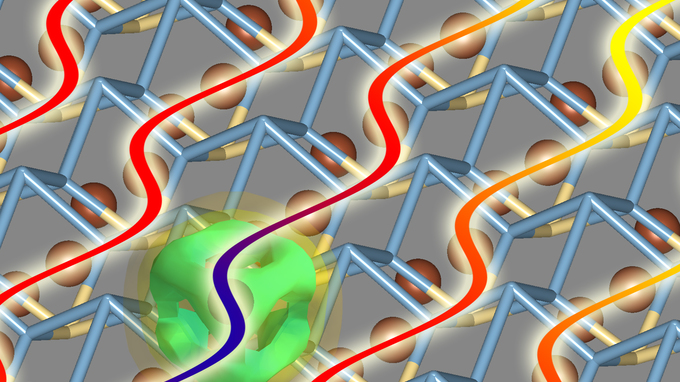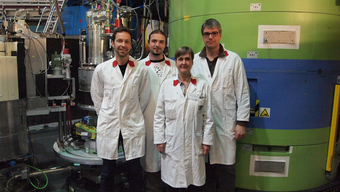Ausnahmen werden zur Regel
Neutronenmessungen zeigen Grenzen einer über 90 Jahre alten Annahme der Physik auf
2019-05-02 – Nachrichten aus dem Physik-Department

Der Zufall wollte es, dass Studenten bei einem Praktikumsversuch an der Forschungs-Neutronenquelle FRM II der TUM an die Grenzen eines über 90 Jahre alten Eckpfeilers der Physik stießen: die Born-Oppenheimer-Näherung. Dr. Astrid Schneidewind, Wissenschaftlerin am Forschungszentrum Jülich, benötigte eine Probe für ihren Praktikumsversuch mit Neutronen. Gleichzeitig war es ihrem Kollegen, TUM-Wissenschaftler Dr. Christian Franz, gelungen zum ersten Mal einen großen Kristall einer neuen Verbindung zu züchten. Motiviert durch Untersuchungen an ähnlichen Substanzen ließ die Wissenschaftlerin ihre Studenten die Substanz aus CeAuAl3 auf ungewöhnliche Anregungen testen. Das Material hatten verschiedene Forscher in Pulverform schon erfolglos an anderen Spektrometern untersucht.
Zufällige Entdeckung

Ohne hohe Erwartungen stellte die Physikerin den Kristall kurzerhand für den Praktikumsversuch über Nacht in ihr Neutronen-Dreiachsenspektrometer PANDA. Umso größer war ihre Überraschung am nächsten Morgen, als Schneidewinds Kollege Dr. Petr Čermák, damals Postdoktorand am Forschungszentrum Jülich, mit den Studenten auf die Messergebnisse blickte. Da waren Kopplungen zwischen den Bewegungen der Atomkerne und den Elektronen zu sehen, die es laut der Born-Oppenheimer-Näherung nicht geben dürfte. Umfangreiche Messungen bestätigten die ersten Ergebnisse: Čermák nutzte PANDA und das Neutronen-Dreiachsenspektrometer PUMA um den Beobachtungen über mehrere Jahre hinweg auf den Grund zu gehen.
Anwendungen für Speichermaterialien und in der Supraleitung
Die Born-Oppenheimer-Näherung aus dem Jahr 1927 ist ein Eckpfeiler der Physik. Sie nimmt an, dass die Bewegungen der Atomkerne und Elektronen in Festkörpern getrennt betrachtet werden können und sich gegenseitig nicht beeinflussen, da die Teilchen sich sehr stark in ihrer Masse unterscheiden. Im Laufe der Zeit entdeckten Forscher immer wieder exotische Materialien oder Zustände, für die diese Näherung nicht galt. „Wir haben nun erstmals nachgewiesen, dass es solche Kopplungen zwischen den Elektronen und ihren Atomkernen in Festkörpern in sehr viel mehr Materialien geben muss als bisher angenommen“, sagt Christian Pfleiderer, Professor für Topologie korrelierter Systeme an der TUM, der bei der Deutung der Messergebnisse behilflich war. „Gleichzeitig eröffnet dies eine große Breite von möglichen Formen elektronischer Ordnung und Funktionalitäten, die durch solche Kopplungen entstehen.“
„Diese ungeahnte Kopplung zwischen Atomkern und -hülle eröffnet viele mögliche Anwendungen, unter anderem für die Datenverarbeitung“, sagt Dr. Petr Čermák, jetzt Wissenschaftler an der Karls-Universität Prag. Auch für das Verständnis der Supraleitung versprechen die Materialien wichtig zu werden.
Veröffentlichung
Weitere Informationen
Verwandte Meldungen
- Schnelles Speichermaterial im Neutronenlicht – 2018-12-07
- Ausbau der Neutronenforschung – 2018-09-04
- Magnetische Wirbel: doppelt interessant – 2018-07-11
- Hohe Auszeichnung für Entdeckung der Skyrmionen – 2016-05-30